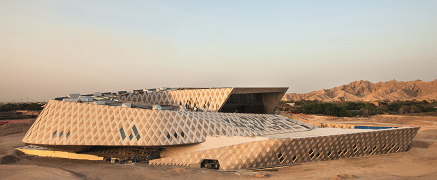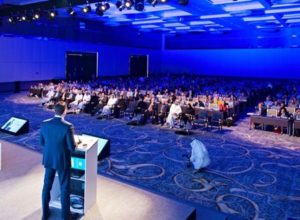UAE: Museum in Al Ain Garden City Receives 5-Pearl Estidama Rating
May 4, 2015
The Sheikh Zayed Desert Learning Center in Abu Dhabi is aiming at becoming the first building to be awarded a 5-pearl Estidama construction rating certificate. The museum and research centre inaugurated in 2015 is located in a tourist area, which includes a 400-hectar wildlife park and a resort consisting of hotels, themed safari tours and residential areas, right on the outskirts of the second-largest city of the emirate, Al Ain, also known as the Garden City. The building has about to achieve Platinum standard, the highest rating of the US LEED (Leadership in Energy and Environmental Design) certification scheme. The owner of the building, state-owned Al Ain Wildlife Park & Resort, paid EUR 56 million for the green showcase project, which has been adapted for the hot and dry desert climate (see the attached PDF). Solarthermalworld.org already reported on the first 4-pearl office building in Masdar City, which was certified according to the newly developed Estidama rating system of the Abu Dhabi emirate.
Photo: Züblin Spezialtiefbau
“Estidama offers two kinds of certification. Regarding design, we have already reached 5 pearls. The certification for the construction rating is still ongoing,” explains Talik Chalabi, Owner of an Austrian architectural office that goes by the same name and which was responsible for planning the complex structure (see the attached PDF).
“The solar cooling system of the building has been essential in gaining 5 pearls, as well as LEED Platinum,” confirms Harald Blazek, Strategic Business Development & Marketing Manager at Austrian turnkey solution provider S.O.L.I.D. His company planned and designed the solar cooling system with a collector field of 1,134 m², which drives a lithium absorption chiller of 352 kW capacity. The solar system supplies the active elements in the concrete walls and ceilings with a cold-water temperature of around 16 °C. In contrast to an air conditioning system with fan coils based on cold-water temperatures of around 7 °C, the active elements in the concrete are reducing the demand for cooling energy. According to S.O.L.I.D. simulations, the solar collectors should achieve an annual specific yield of 825 kWh/m². But the sun only contributes between 10 to 15 % to the annual cooling supply of the building. The largest part of the cooling load is covered by six closed-circuit cooling towers in conjunction with compression chillers.
| Category name |
Number of points |
| Improved Energy Performance |
15 |
| Cool Building Strategies |
6 |
| Energy Efficient Appliances |
3 |
| Vertical Transportation |
3 |
| Peak Load Reduction |
4 |
| Renewable Energy |
9 |
| Global Warming Impact of Refrigerants & Fire Suppression System |
4 |
| Total Resourceful Energy |
44 |
Maximum number of points in the subcategories of the Resourceful Energy section
Source: Pearl Rating System for Estidama, Version 1.0 from April 2010 (see the attached PDF)
The Estidama methodology grants one to eight points for an onsite renewable energy share of 1 to 20 % (see the table above). A 150 kWp photovoltaic generator with glass-glass modules has been integrated into the building roof. Together with the solar thermal collectors, which were installed next to the building, the solar energy share, under regular full occupancy, is between 15 to 20 % based on calculations using the ASHRAE appendix G Energy Balancing Method. “In reality, the solar contribution will be greater and account for approximately 30 % of the annual energy demand, depending on the annual weather profile and occupancy rates,” assumes Klaus Kogler, Senior Expert for Innovative Building Services Engineering and RTD Services at Austrian CES clean energy solutions. CES was commissioned to plan the renewable energy systems according to case study brochure Building innovations from Austria in the Arab world, which was financed by the Austrian Ministry for Transport, Innovation and Technology (see the attached document).
“Although the share of solar cooling is not the most important figure for Estidama certification, the technology can reduce the electricity peak load of the building in combination with the cooled concrete in the floors and in the ceiling, which can be worth up to 4 additional points in the Estidama scheme,” explains Kogler. “If you want to reach 5 pearls, every point counts and the latter ones can cost you EUR 100,000 or more,” he adds. In total, you can reach a maximum of 44 points in the Resourceful E category – round about 26 % of the maximum number of points within the Estidama certification scheme (see the table below).
| Category name |
Number of points |
| Integrated Development Process |
13 |
| Natural Systems |
12 |
| Liveable Buildings |
33 to 37 |
| Precious Water |
43 to 45 |
| Stewarding Materials |
28 |
| Innovating Practice |
3 |
| Resourceful Energy |
44 |
| Total number of points |
170 to 179 |
Maximum number of points in different ecological sections for the certification of offices, single-family homes, multi-family buildings and schools. Some categories differ from building type to building type.
Source: Pearl Rating System for Estidama, Version 1.0 from April 2010
More information:


